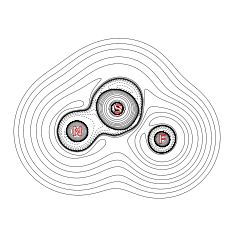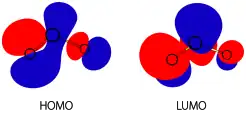Thiazyl fluoride
Thiazyl fluoride, NSF, is a colourless, pungent gas at room temperature and condenses to a pale yellow liquid at 0.4 °C.[1] Along with thiazyl trifluoride, NSF3, it is an important precursor to sulfur-nitrogen-fluorine compounds. It is notable for its extreme hygroscopicity.
 | |
 | |
| Identifiers | |
|---|---|
3D model (JSmol) |
|
| ChemSpider | |
PubChem CID |
|
CompTox Dashboard (EPA) |
|
| |
| |
| Properties | |
| NSF | |
| Molar mass | 65.07 g mol−1 |
| Appearance | colourless gas |
| Melting point | −89 °C (−128 °F; 184 K) |
| Boiling point | 0.4 °C (32.7 °F; 273.5 K) |
Except where otherwise noted, data are given for materials in their standard state (at 25 °C [77 °F], 100 kPa).
Infobox references | |
Synthesis
Thiazyl fluoride can be synthesized by various methods, such as fluorination of tetrasulfur tetranitride with silver(II) fluoride or mercuric fluoride. It can be purified by vacuum distillation.[2][3] However, because this synthetic pathway yields numerous side-products, an alternative approach is the reaction of imino(triphenyl)phosphines with sulfur tetrafluoride by cleavage of the bond to form sulfur difluoride imides and triphenyldifluorophosphorane.[4] These products readily decompose yielding thiazyl fluoride.
For synthesis on a preparative scale, the decomposition of compounds already containing the moiety is commonly used:
Reactivity
Reactions with electrophiles and Lewis acids
Lewis acids remove fluoride to afford thiazyl salts:[5]
- NSF + BF3 → [NS]BF4
Thiazyl fluoride functions as a ligand in [Re(CO)5NSF]+.[1] and [M(NSF)6]{+2} (M = Co, Ni). In all of its complexes, NSF is bound to the metal center through nitrogen.[6]
Reactions with nucleophiles
Thiazyl fluoride reacts violently with water:[7]
- NSF + 2 H2O → SO2 + HF + NH3

Nucleophilic attack on thiazyl fluoride occurs at sulfur atom:.[8]
- NS−F + Nu− → NS−Nu + F−
Fluoride gives an adduct:
- NS−F + F− → NSF−2
The halogen derivatives XNSF2 (X = F, Cl, Br, I) can be synthesized from reacting Hg(NSF)2 with X2; whereby, ClNSF2 is the most stable compound observed in this series.[9]
Oligimerization and cycloaddition
At room temperature, thiazyl fluoride undergoes cyclic trimerization via the multiple bonding:
1,3,5-trifluoro-1,3,5,2,4,6-trithiatriazine is the yielded cyclic trimer, where each sulfur atom remains tetravalent.
Thiazyl fluoride also reacts via exothermic cycloaddition in the presence of dienes.
Structure and bonding

The N-S bond length is 1.448 Å, which is short, indicating multiple bonding, and can be represented by the following resonance structures:
The NSF molecule has 18 total valence electrons and is isoelectronic to sulfur dioxide. Thiazyl fluoride adopts Cs-symmetry and has been shown by isotopic substitution to be bent in the ground state.[10][11] A combination of rotational analysis with Franck-Condon calculations has been applied to study the electronic excitation from the A''A' states, which results in the elongation of the bond by 0.11 Å and a decrease in the NSF by 15.3.
References
- Oskar Glemser and Rüdiger Mews (1980). "Chemistry of Thiazyl Fluoride (NSF) and Thiazyl Trifluoride (NSF3): A Quarter Century of Sulfur-Nitrogen-Fluorine Chemistry". Angew. Chem. Int. Ed. Engl. 19 (11): 883–899. doi:10.1002/anie.198008831.
- Fischer, Gad (1974-05-01). "Vibrational assignments in the electronic spectra of thiazyl fluoride". Journal of Molecular Spectroscopy. 51 (2): 208–215. doi:10.1016/0022-2852(74)90050-2. ISSN 0022-2852.
- Glemser, Oskar; Schröder, Hans; Haeseler, Harke (1955-01-01). "Über Schwefel-Stickstoff-Fluorverbindungen". Naturwissenschaften (in German). 42 (2): 44. doi:10.1007/BF00621536. ISSN 1432-1904. S2CID 32868758.
- Appel, Rolf; Laßmann, Eberhard (July 1971). "Über eine neue Synthese des Thiazylfluorids, NSF". Chemische Berichte. 104 (7): 2246–2249. doi:10.1002/cber.19711040727. ISSN 0009-2940.
- Mews, Rüdiger (November 1976). "Das Thionitrosylkation NS+ als Synthesereagens". Angewandte Chemie (in German). 88 (22): 757–758. doi:10.1002/ange.19760882205.
- Oskar Glemser and Rüdiger Mews (1980). "Chemistry of Thiazyl Fluoride (NSF) and Thiazyl Trifluoride (NSF3): A Quarter Century of Sulfur-Nitrogen-Fluorine Chemistry". Angew. Chem. Int. Ed. Engl. 19 (11): 883–899. doi:10.1002/anie.198008831.
- Mews, Rudiger; Keller, Klaus; Glemser, Oskar; Seppelt, K.; Thrasher, J. (2007-01-05), Shreeve, Jean'ne M. (ed.), "Acyclic Sulfur Nitrogen Fluorine Compounds", Inorganic Syntheses, Hoboken, NJ, USA: John Wiley & Sons, Inc., pp. 12–17, doi:10.1002/9780470132555.ch6, ISBN 978-0-470-13255-5, retrieved 2022-12-15
- Cohen, B.; Hooper, T. R.; Hugill, D.; Peacock, R. D. (August 1965). "Preparation of Thiazyl Fluorides". Nature. 207 (4998): 748–749. doi:10.1038/207748b0. ISSN 1476-4687. S2CID 4163539.
- Glemser, Oskar; Mews, Rüdiger; Roesky, Herbert W. (May 1969). "Darstellung und Eigenschaften von Quecksilber‐bis‐schwefeldifluoridimid, N ‐Chlor‐schwefeldifluoridimid und N ‐Brom‐schwefeldifluoridimid". Chemische Berichte. 102 (5): 1523–1528. doi:10.1002/cber.19691020513. ISSN 0009-2940.
- So, Suk Ping; Richards, W. Graham (1978-01-01). "Geometries and stabilities of NSF and SNF". Journal of the Chemical Society, Faraday Transactions 2: Molecular and Chemical Physics. 74: 1743–1745. doi:10.1039/F29787401743. ISSN 0300-9238.
- Dixon, R. N.; Duxbury, G.; Fleming, G. R.; Hugo, J. M. V. (1972-05-01). "The photoelectron spectrum of thiazyl fluoride". Chemical Physics Letters. 14 (1): 60–63. doi:10.1016/0009-2614(72)87141-0. ISSN 0009-2614.



